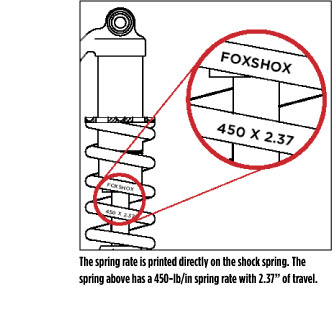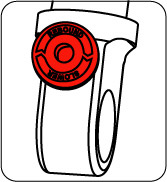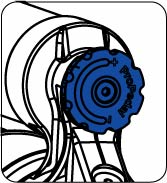|
|
Installing Your Shock | General Maintenance | Before You Ride | Setting Sag | Changing Springs | Measuring Sag | Adjusting Rebound | ProPedal | Boost Valve | Service Intervals | Important Safety Information
|
|
features/adjustments |
position-sensitive Boost valve, adjustable ProPedal, adjustable tuning range via Schrader valve, coil spring preload, rebound adjust |
|
spring |
coil |
|
|
intended use |
If you are installing your shock on a bike in which the shock is not original equipment:
Some things to consider:
Note: Do not use any solvents or de-greasers, as these products can damage the shock's exterior finish or its anodized parts.
Do not spray water directly on the seal/shock body junction. Do not use a high pressure washer on your shock.
You can also view a Flash video on Setting Sag.
To set sag on your DHX 4.0:
If sag is lower than on the table, turn the pre-load ring counterclockwise. Always ensure that the spring is secure and does not freely move.
Note: After the preload ring engages the spring, turn the preload ring clockwise one turn. If the preload ring needs to be turned counterclockwise from this point to achieve proper sag, you will need to obtain a lower rate spring.
If sag is higher than on the table, turn the preload ring clockwise no more than two full turns after the preload ring engages the spring.
Note: If after the preload ring engages the spring and more than two full clockwise turns are needed to achieve proper sag, you will need to obtain a higher rate spring.
Shock Travel | Recommended Sag |
2.00/50.8 | 0.66/16.76 |
2.25/57.1 | 0.74/18.79 |
2.50/63.5 | 0.83/21.08 |
2.75/69.8 | 0.91/23.11 |
3.00/76.2 | 1.00/25.40 |
3.50/88.9 | 1.16/29.46 |
When placing the spring back on the shock body, it is important that the spring is correctly oriented. Essentially, the space in the spring retainer should rest on the flat part of the spring, and not on the segment of the spring where it starts to coil back under itself. Rotate the spring or spring retainer until the correct orientation is achieved.
An improperly oriented spring can fail prematurely, causing loss of control of the bicycle, which can result in serious or fatal injuries. The pictures below demonstrate correct and incorrect spring orientation. Correct spring orientation applies to all FOX Racing Shox rear shocks that utilize coil springs:


Rebound controls the rate at which your shock returns after it has been compressed. The proper rebound setting is a personal preference, and changes with rider weight, riding style and conditions. A rule of thumb is that rebound should be as fast as possible without kicking back and pushing the rider off the saddle.
The rebound knob has approximately 15 clicks of adjustment.
For slower rebound, turn the red adjuster knob clockwise.
For faster rebound, turn the red adjuster knob counterclockwise.

The ProPedal adjustment knob allows the rider to adjust the amount of ProPedal damping. ProPedal damping affects the initial part of the compression stroke and is designed to control pedal-induced suspension bob. Since suspension designs vary, not all bicycles require the same degree of ProPedal damping.
There are 15 clicks of adjustment.
For lighter ProPedal damping, rotate the ProPedal knob counterclockwise.
For increased ProPedal damping, rotate the ProPedal knob clockwise.

The Boost Valve creates a position-sensitive damping scheme that allows for a seamless transition from efficient ProPedal to square-edge bump absorption to a bottomless end-of-stroke feel. The Boost Valve also decouples the ProPedal and the factory-set bottom-out resistance, enabling ProPedal adjustments to be made without affecting the compression damping curve.
The Boost Valve is not adjusted directly. Instead, its behavior and performance characteristics are influenced by the air pressure setting in the reservoir and by adjusting the ProPedal knob.
To change the compression damping characteristics of your DHX 4.0 shock, attach a FOX High Pressure Pump to the air valve on the reservoir:
For a firmer ride, add 10 – 15 pounds of air pressure, to a maximum of 200 PSI.
For a softer ride, decrease the shock’s air pressure 10 – 15 pounds by using the pump’s bleed valve, to a minimum of 125 PSI.
Ride your bike and verify the settings before repeating the procedure.
CAUTION: Never ride your bike with more than 200 PSI or less than 125 PSI in the reservoir air chamber. Doing so can damage your shock and require repairs that are NOT covered under warranty.
Certain aspects of the Boost Valve can influence the ProPedal adjustment.
If the ProPedal adjustment knob is fully counterclockwise (lightest ProPedal damping position) and the compression damping is still too strong, attach a shock pump to the Schrader valve on the reservoir and reduce the pressure 10 – 15 PSI. Repeat to achieve the desired compression damping.
If there is not enough compression damping with the ProPedal knob fully clockwise, add 10 – 15 PSI to the Boost Valve until desired compression damping is achieved.
![]()

Bushing Technology & Inspection | Seals & Foam Rings | Control Direction | Oil Volumes | Structural Inspection | Dropout Thickness Inspection | Torque Values | Unit Conversion | Suspension Tuning Tips | Using the Pump | Important Safety Information | Service Intervals | Contact FOX Service | Warranty Information | FOXHelp Service Web Site
Copyright © 2010
FOX Factory Inc.